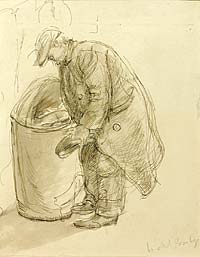The impulse toward mark-making is ancient and ever present. Give a kid a crayon and watch the walls in his or her room blossom with lines. The Asheville Art Museum’s current exhibit, Lines of Discovery: American Drawings, takes a chronological look at drawing in America.

The Oxford American Dictionary defines drawing as “a picture drawn but not colored,” but this exhibition broadens that description considerably. There are almost as many media as styles. Some of the earliest pieces are landscapes by famous painters, but the most interesting of these early works is a small pencil-and-wash drawing from the late 1800s of a team of five horses pulling a trolley. The artist, Abbott Handerson Thayer, may not be a household name, but the skill of the sharp, quickly executed pencil lines intersecting the animals bodies testify to their strength and to the artist’s ability.
Most of the famous names from the turn of the century are represented. There are landscapes by Robert Henri and Ernest Lawson, a wonderful portrait by George Bellows, and groups of figures by John Sloan, George Luks and William Glackens. The Glackens drawing, called “Mulberry Street,” was done in 1905 and is a record of the diverse ethnicity of that neighborhood.
There is a great John Marin watercolor: loose, spontaneous, almost careless in its execution. And, to be expected in any drawing show, there are figure studies. You have to wonder if Willem de Kooning ever saw the small, untitled study of a woman by Hans Hofmann done in 1935. The figure lacks the de Kooning women’s fierceness, but Hofmann’s strong lines break the body in a very similar way. Brown and black markers are Milton Avery’s tools for his “Nude on Chair.” The black marker is only used to make tiny dots where the lines of the body change direction. By far the most erotic work in the exhibition is the untitled male nude by Paul Cadmus. A handsome, sloe-eyed young man languishes horizontally across the page, his genitals coyly hidden by the loose ties of a powder-blue robe.
Two of the more interesting figure studies in the show share one thing—they both depict men in overcoats. Here the similarities end: Isabel Bishop’s small drawing titled “The Ashcan” shows a man in a cap and a rumpled coat picking through garbage. The pen is held lightly; there is the feeling that this man is part of something larger, but not seen. William Beckman’s “Overcoat Series No. 3” is a huge drawing. There are two over-life-sized figures, one a self-portrait and the other a portrait of the artist’s ex-wife. Beckman is posed in a stylish overcoat with his hands in his pants pockets. The woman is nude and perches on the edge of a stool. The figures are self absorbed and isolated, not only by the space between them, but by decisive heavy outlines around their bodies.
For works of sheer joy, the Robert Motherwell pieces from his Lyric Suite stand above everything else. These small squares in ink on rice paper are, without question, marks made by a master.
[Connie Bostic is an Asheville-based painter and writer.]
who: The Asheville Art Museum presents Lines of Discovery
what: A chronological exploration of American drawings
where: Asheville Art Museum
when: Through Sunday, Feb. 10 ($6 museum admission. www.ashevilleart.org or 253-3227)



Before you comment
The comments section is here to provide a platform for civil dialogue on the issues we face together as a local community. Xpress is committed to offering this platform for all voices, but when the tone of the discussion gets nasty or strays off topic, we believe many people choose not to participate. Xpress editors are determined to moderate comments to ensure a constructive interchange is maintained. All comments judged not to be in keeping with the spirit of civil discourse will be removed and repeat violators will be banned. See here for our terms of service. Thank you for being part of this effort to promote respectful discussion.